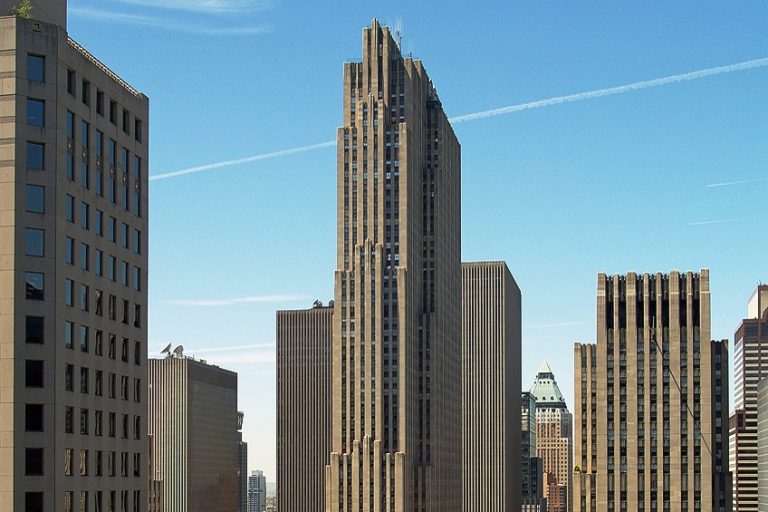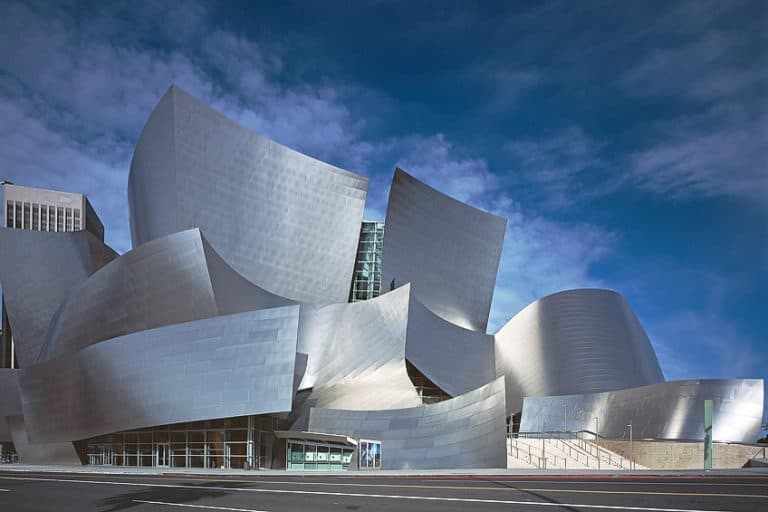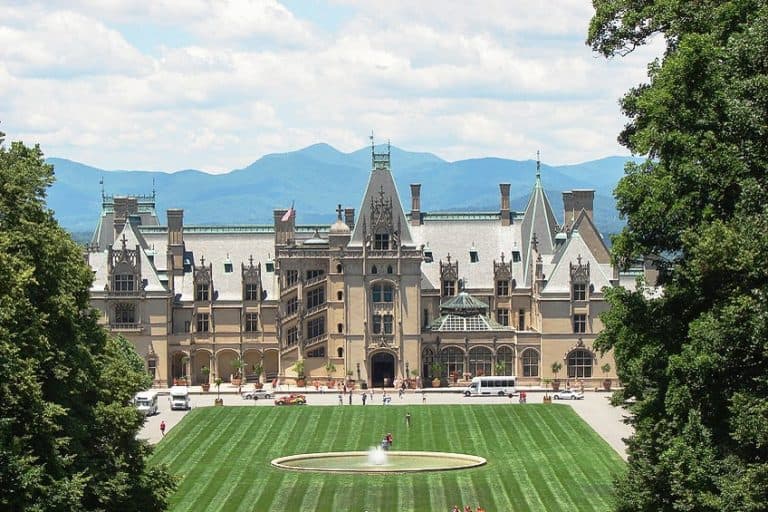Medieval Architecture – A Look at the Best Medieval Buildings
Medieval architecture is the term given to Medieval buildings created during the Middle Ages, which encompass civic, ecclesiastical, and military structures. Pre-Romanesque, Romanesque, and Gothic are the main styles used in Middle Ages architecture. While cathedrals and castles constitute the majority of the surviving Medieval structures, examples of municipal and Medieval-style houses may be found across Europe.
Exploring Medieval Architecture
When discussing the genre of Medieval architecture, Medieval buildings can be split into three categories. The Middle Ages architecture types include military, religious, and civic architecture. Let us explore the types of Medieval structures below.
Religious Medieval Architecture
The Latin cross plan, which was popular in Medieval religious architecture, is based on the Roman basilica as its fundamental model, with additional variations. It has transepts, a nave, and the altar is at the east end. Furthermore, cathedrals affected or built by Justinian used the Byzantine design of domed roofs and the Greek cross, with the sanctuary’s altar on the eastern side of the temple.
Churches were an important source of municipal pride in Medieval England, and towns competed to build the most spectacular church.

Indulgences were sold to raise funds for the church building, as were relic caravans, donations from lords, and parish contributions. Town guilds would often pay for stained glass windows depicting their trade. Townspeople occasionally volunteered to help in church construction. Many Medieval English churches were erected in significant pre-Christian locations to capitalize on preexisting spiritual devotion to the location.
The main altar of churches was constructed to face the sun rising at the eastern end of the structure.
Military Middle Ages Architecture
The remaining Medieval architecture was mostly used for defense. The most noteworthy non-religious forms of Medieval architecture are castles and reinforced walls. Windows were given a cross-shape for more than just decoration; they were a great fit for a crossbowman to securely aim at intruders from within.
When not firing against attackers, archers on the rooftops might conceal behind battlements.
Medieval-Style Houses
Medieval architecture was not only visible in military and religious Medieval buildings. While most of the extant Medieval architecture is ecclesiastical or military in nature, instances of municipal and even household Medieval structures can be found throughout Europe.
Manor buildings, almshouses, town halls, and bridges are instances, but so are residential Medieval-style houses.

Medieval Architecture Styles
England’s Medieval architects wanted to reflect the country’s vast history. From spectacular cathedrals to massive fortifications, the area is home to hundreds of outstanding Medieval structures that provide a glimpse into what it was like to reside and serve in the area from the 11th to 15th centuries.
Let us now explore the various styles associated with Middle Ages architecture.
Pre-Romanesque
Early Christian, Pre-Romanesque, Russian church architecture, and Norse architecture are all types of European architecture in the Early Middle Ages. Trachtenberg’s “historicizing” and “modernizing” aspects, Italian vs northern, Spanish, and Byzantine factors, and notably religious and geopolitical machinations between monarchs, the papacy, and other ecclesiastic officials are all factors that come into the history of each time.
Romanesque
The Romanesque era, which began with the Norman period in the 11th century, represented the beginning of Medieval architecture. This style was called after the proportions and patterns found in Roman Empire buildings. Romanesque architecture has barrel vaults, massive piers, rounded archways, and just a few windows.
Round arches are most visible at door and window openings. Many instances of Medieval Romanesque churches may still be seen in England.

They were ornamented with vividly colorful tapestries and paintings when they were created, but they appear dismal and melancholy to modern tourists. Many structures, particularly churches, have richly colored walls, arches, and columns.
Arches etched with diagonals or studded with animal heads were frequent for doors, while the tops of columns were usually engraved with various designs.
Gothic Architecture
In the 12th century, the Gothic architectural style first developed in England. This style developed in France and was first referred to as “the French Style,” but Renaissance critics dubbed it “Gothic” because it rejected classical lines and proportions.
To critics, Gothic architecture demonstrated a lack of creativity characteristic of barbaric tribes such as the Goths who devastated Rome before its fall.
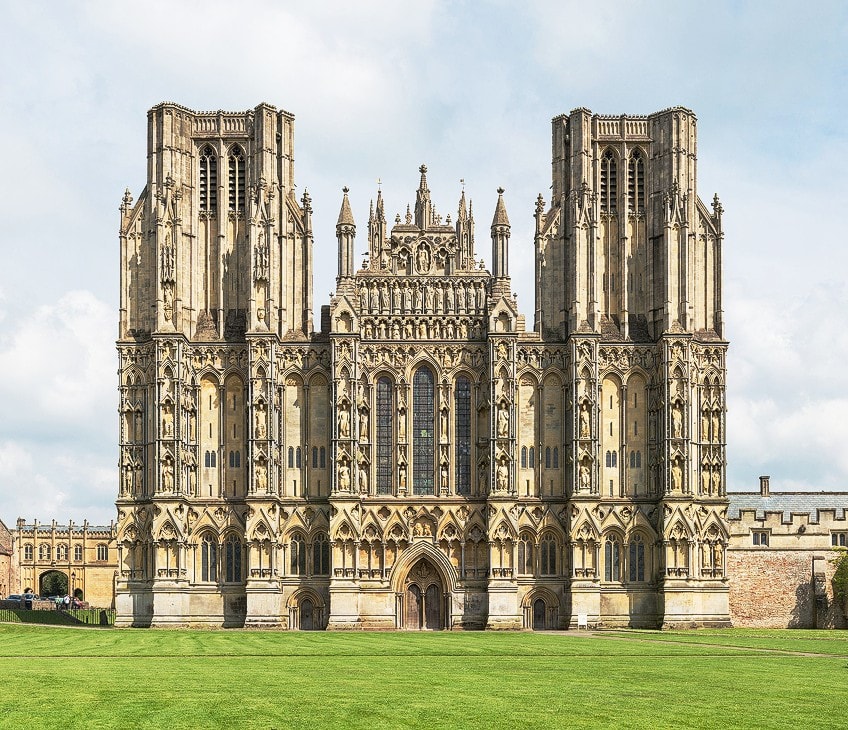
With pointed arches and ribbed vaults, English Gothic architecture is exceptionally beautiful and light. Rather than strong Romanesque piers, Gothic architecture emphasized slender groupings of columns with huge windows and lofty ceilings and spires.
Sculptures in structures became free-standing during this time, rather than being placed into columns.
Famous Medieval Buildings
Next, we will discover the most renowned exemplars of Medieval architecture. Despite being created hundreds of years ago, these Medieval structures have managed to overcome time and environmental and political factors. Here are our favorite examples of Middle Ages architecture.
York Minster (York, England)
| Date Completed | 637 AD |
| Architect | Walter de Gray (1180 – 1255) |
| Function | Abbey |
| Location | York, England |
Originally a tiny wood church, York Minster underwent several changes in the Medieval era before becoming the Gothic cathedral it is today. Before being rebuilt with a stone church in AD 640, York Minster was initially constructed as a tiny wooden structure in AD 627. The church withstood a Viking raid in AD 866, and William the Conqueror’s troops ravaged it in 1069. Following its destruction, William named a Norman archbishop of York and the building of a massive Norman Cathedral started.
When Walter De Gray made the decision to remodel the cathedral in the Gothic style, the cathedral was rebuilt in the 13th century.
The new cathedral took more than 250 years to create, but it was ultimately done in 1472. The greatest surviving example of Medieval glass in all of Europe is the Great East Window of York Minster, which was constructed between 1405 and 1408. The Minster contains some stained glass that was created in the 12th century. The cathedral’s nave was constructed in the Gothic style between 1291 and 1350.

The Great West Window, also known as the Heart of Yorkshire, is located to the west of the largest Gothic nave in England, which has a timber ceiling that has been painted to resemble stone. The Perpendicular Gothic architectural style was used in the construction of York Minster’s east end from 1361 and 1405. The two west towers are equipped with clock chimes, a concert carillon, and bells. The northwest tower’s Great Peter bell weighs around 11 tons.
The second-largest Gothic cathedral in Northern Europe is York Minster. It has become one of just seven cathedrals with its own police force worldwide.
Berkhamsted Castle (Berkhamsted, England)
| Date Completed | 1066 |
| Architect | Robert, Count of Mortain (1031 – 1095) |
| Function | Castle |
| Location | Berkhamsted, England |
The Medieval architect behind the construction of this castle received the Honor of Berkhamsted after William the Conqueror beat King Harold II and received the crown at Westminster Abbey. Berkhamsted Castle was built under Robert’s direction and was finished in 1066. A civil conflict besieged the fortress in 1216 after it had been later extended in the 12th century.
It was handed to Richard, Earl of Cornwall, who converted the fortress into a palace when it was retaken by royal forces. The castle was in disrepair and finally in ruins by the 15th century.

Even the castle’s stones were used to construct residences and other structures in the nearby town. It was almost completely demolished during the 19th-century Birmingham and London Railway construction, and as a result, it was the first British structure to be granted legislative protection.
As a historic monument, the ruins are currently covered by legal protection.
Lincoln Cathedral (Lincoln, England)
| Date Completed | 1072 |
| Architect | Sir Christopher Wren (1632 – 1723) |
| Function | Cathedral |
| Location | Lincoln, England |
Architectural experts hold the Lincoln Cathedral, in high respect. Author John Ruskin referred to it as “the most exquisite work of architecture in all of the British Isles.” The Gothic-style Lincoln Cathedral was created between 1185 and 1311, although it has since undergone several additions and improvements. The stained glass is one of the Lincoln Cathedral’s most striking elements.
The Bishop’s Eye and the Dean’s Eye are two substantial stained glass rose windows in the cathedral that was installed during the Middle Ages.
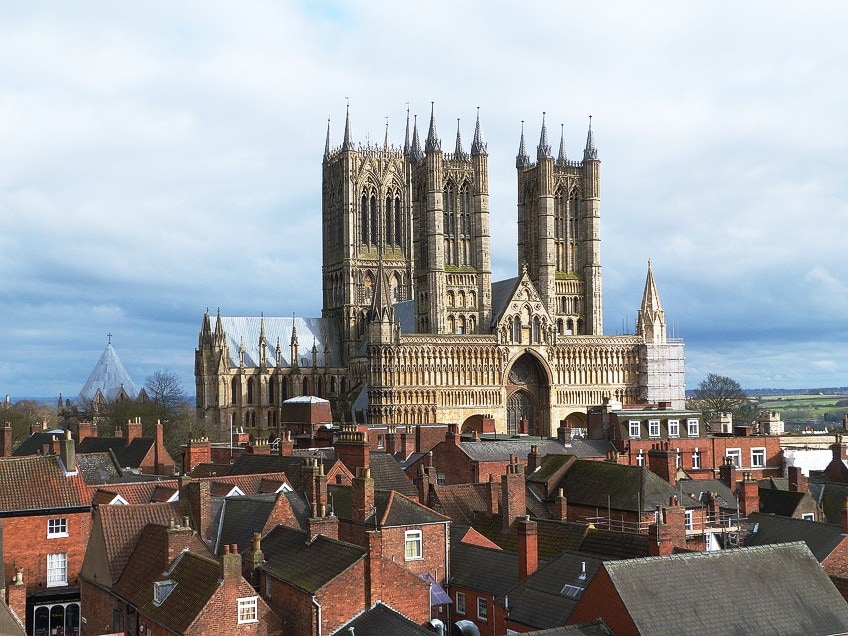
In the architecture of Medieval Europe, rose windows were quite rare. In addition, there are 13 bells in the southwest tower, 5 in the center tower, and 2 in the northwest tower of the cathedral. Among the cathedral’s stone sculptures is the Lincoln Imp. Mythology from the 14th century claims that Satan dispatched two imps to perform mischief. The imps arrived at Lincoln Cathedral, where an angel told them to halt. The imp was turned to stone as he started hurling pebbles at the angel from atop a pillar. According to legend, the stone imp may still be seen atop the pillar in the cathedral’s Angel Choir.
After the Great Pyramid of Giza, the Lincoln Cathedral was the first structure to claim the title of the world’s tallest building when it was built in 1549. After York Minster and St. Paul’s, it is also Britain’s largest cathedral in terms of floor size.
White Tower (London, England)
| Date Completed | 1097 |
| Architect | Gundulf of Rochester (1024 – 1108) |
| Function | Palace |
| Location | London, England |
William the Conqueror constructed the White Tower to subjugate the populace and solidify his control over London. The White Tower, which is at the center of the Tower of London, was the first piece of Norman architecture to be completed in England and was constructed between 1070 and 1100. Norman masons erected the spectacular tower, and William even transported stones from Normandy for the building.
The White Tower, at 27.5 meters tall, would have been seen from a long way when it was initially built.
In the northeast, there are circular towers with spiral staircases, while in the western corners, there are square towers. In the southeast corner, a projection of St. John’s Chapel may be observed. In terms of castle architecture, the chapel’s distinctive design still stands out. In the 17th and 18th centuries, Portland stone replaced the original Caen stone that had been brought from France. The White Tower was built with protection, not luxury, in mind; it was more of a fortress than a palace.
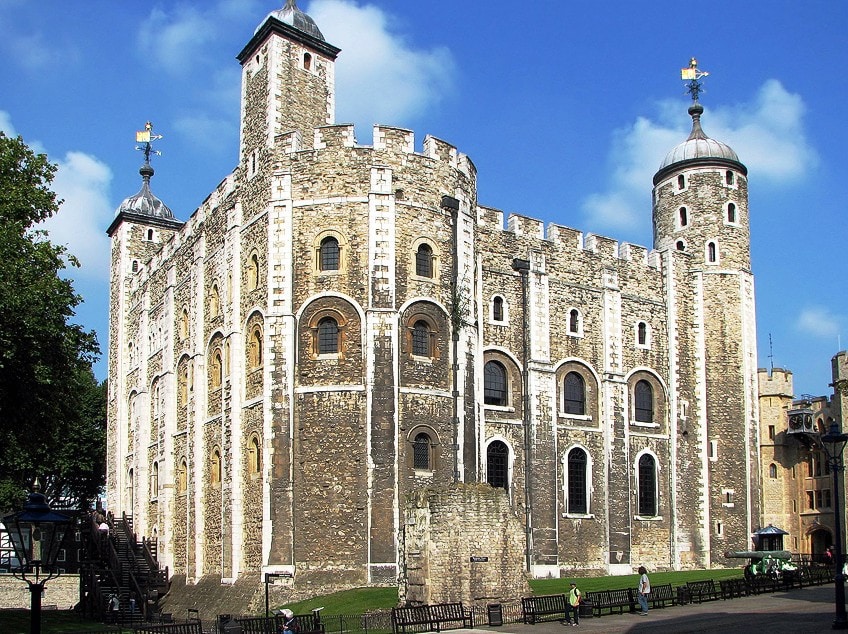
The White Tower’s defenses were reinforced several times during the Medieval era, and Richard the Lionheart more than quadrupled its size. While Richard was in power, his brother John invaded the White Tower and attempted to take the kingdom. The tower held, but the soldiers guarding it had to give up since they were out of supplies.
The tower served as a jail as well. Richard II was reportedly imprisoned in the White Tower after he was made to abdicate the crown, and Guy Fawkes is said to have been interrogated there.
Henry III requested that the tower be whitewashed in 1240, presumably because it was fashionable to paint famous structures a sparkling white during the period in Europe. The chapel’s interior was beautifully embellished with statuary and stained glass. One of the most intact palaces from the 11th century in Europe is the White Tower, often known as the Tower of London.
All Saints Church (Hampshire, England)
| Date Completed | 1130 |
| Architect | Unknown |
| Function | Church |
| Location | Hampshire, England |
One of England’s most exquisite specimens of early Norman construction is the All Saints Church in East Meon, Hampshire. With a square Norman tower in the middle and distinct Romanesque arches, the church was constructed in the shape of a cross. The church’s spectacular Romanesque friezes, which were carved by Flemish artisans, show the Expulsion from the Garden on the eastern side, the creation of Adam and Eve on the northern side, and creatures and monsters on the west and south faces.
According to parish history, the church was built in 1080, however, a different source dates its construction to between 1130 and 1140.

The church that we see now is largely that of the invaders; it was likely erected in the place of an earlier Anglo-Saxon building. Sir Ninian Comper designed the Lady Chapel’s eastern window, as well as the chapel’s woodwork, during his 20th-century reconstruction.
The aisle and southern chapel in the Early English style date from the early 13th century, with the windows in the south aisle, added later.
The 18th-century high pews and galleries were removed during the interior restoration project overseen by Ewan Christian in 1870. Sir Ninian Comper then rebuilt the interior between 1906 and 1922, adding the replica perpendicular eastern window in the chancel, the altar, and the screen separating the chancel from Lady’s Chapel.
Durham Cathedral (Durham, England)
| Date Completed | 1133 |
| Architect | George Gilbert Scott (1811 – 1878) |
| Function | Cathedral |
| Location | Durham, England |
Durham Cathedral’s construction began in 1093 and was finished in 40 years. The cathedral is regarded as one of the outstanding instances of Norman architecture in England, and it is the only church in the country that retains virtually all of its original Norman craftsmanship. The present cathedral was established during the reign of William of St. Carilef, William the Conqueror’s first prince-bishop.
While the cathedral has undergone several alterations since then, the majority of the edifice remains in its Norman style.
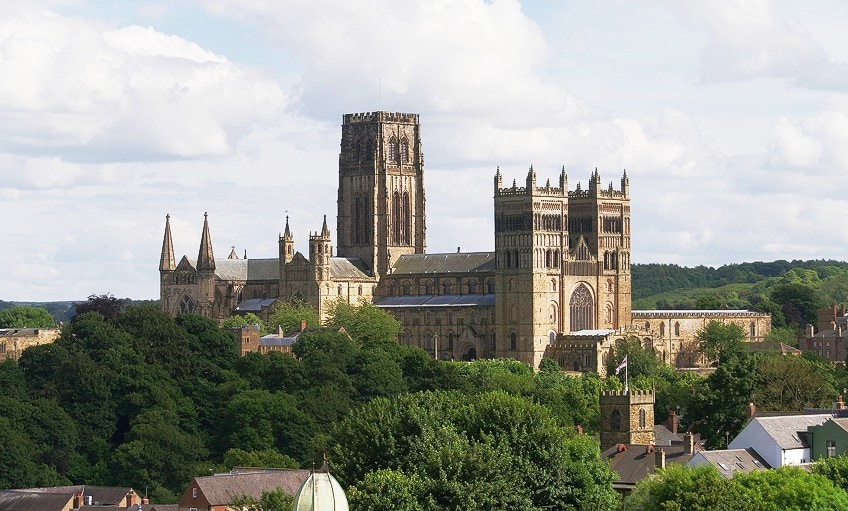
Durham Cathedral was notably used as the learning institution in the Harry Potter films. The spire was created digitally for the summits of the buildings. Durham Cathedral was erected to hold St. Cuthbert’s and Venerable Bede’s remains.
It testifies to the early Benedictine monastic community’s prominence and is England’s biggest and greatest example of Norman construction.
Dover Castle (Dover, England)
| Date Completed | c. 12th-century |
| Architect | Maurice the Engineer (c. 12th century) |
| Function | Castle |
| Location | Dover, England |
Dover Castle is a defensive stronghold with a lengthy and fascinating history. It is often referred to as the “key to England.” This castle is located where England’s quickest maritime route to the continent crosses, making it a crucial strategic point for the region’s defense. King Henry II erected the majority of Dover Castle in the 1180s, not just to protect England from enemies but also to amuse visitors.
The castle’s fortifications were put to the test in 1217 when French forces besieged it, but they held out for 10 months of bombardment.
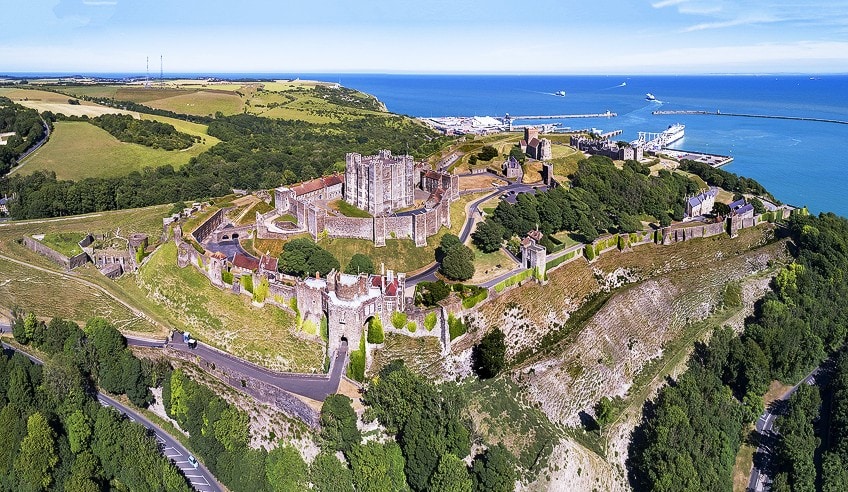
Before the Roman invasion in AD 43, this site may have been defended with earthworks during the Iron Age or earlier. This is hypothesized based on the unique layout of the earthworks, which doesn’t appear to match the Medieval castle perfectly. Although there is evidence of Iron Age occupancy close to the castle from excavations, it is unclear if this is connected to the hillfort.
The location is also home to one of Dover’s two lighthouses, the tallest and most complete existing Roman building in England, and one of just three Roman-era lighthouses that are still in existence today.
Westminster Abbey (Westminster, England)
| Date Completed | 1269 |
| Architect | Ptolemy Dean (1968 – Present) |
| Function | Abbey |
| Location | Westminster, England |
One of the most well-known instances of Medieval architecture is Westminster Abbey in London, which has a significant place in English royal history. Since 1066, every royal coronation has taken place at Westminster Abbey, which also serves as the ultimate resting place for 17 kings and queens.
The earliest altarpiece in England, which was recovered in Abbey’s storage room in 1725, is one of the many works of Medieval art that can be seen inside Westminster Abbey, a stunning example of Gothic architecture.

Here, Edward, the Confessor created the Romanesque style for the first time, and Henry III started the almost 300-year-long Gothic reconstruction of the site. Between 1042 and 1052, King Edward the Confessor began rebuilding St. Peter’s Abbey to provide himself with a royal burial chapel. It would become the nation’s first Romanesque-style church. Dec. 1065 saw its completion, only one week before Edward passed away. During that year, after his funeral at the church, William the Conqueror was enthroned.
Henry III undertook a significant reconstruction between 1245 and 1272 to create the current Westminster Abbey.
It is thought that Henry constructed Westminster Abbey to win Edward the Confessor’s favor, the long-dead Anglo-Saxon monarch. Henry made Edward his patron saint in the hopes that Edward would help him both in this life and the next and guide him to the afterlife. Westminster Abbey, which has a more than a thousand-year history, has more than one million tourists each year.
That concludes our exploration of Medieval architects and their buildings. Ecclesiastical, municipal, and military constructions that date back to the middle centuries are included in the category of Medieval architecture. Gothic, Romanesque, and Pre-Romanesque are a few of the Middle Ages architectural styles. While the bulk of the remaining Medieval buildings is cathedrals and castles, examples of Medieval-style residences and municipal buildings may be seen all throughout Europe.
Frequently Asked Questions
What Is Medieval Architecture?
Buildings constructed throughout the Middle Ages, which generally spanned the fifth to the 15th century, are referred to as Medieval architecture. The architecture was developed further throughout the so-called Renaissance, building on earlier achievements. Instances of Medieval architecture are often only found in Scandinavia, western, central, and southern Europe. There are four categories of Medieval architecture, namely: the mighty, the holy, the civic, and the utilitarian.
What Happened to Medieval Forts?
Forts were gradually supplanted by castles across Europe. According to archaeology, hill forts were constructed throughout the early Middle Ages, often referred to as the Dark Ages in Britain. Burghs, which may be seen in cities like Banbury and Edinburgh, are a series of timber defenses constructed by various monarchs including Alfred the Great. In the 11th century, largely by Norman lords, the stone castles that still dot the region were first constructed.
Justin van Huyssteen is a freelance writer, novelist, and academic originally from Cape Town, South Africa. At present, he has a bachelor’s degree in English and literary theory and an honor’s degree in literary theory. He is currently working towards his master’s degree in literary theory with a focus on animal studies, critical theory, and semiotics within literature. As a novelist and freelancer, he often writes under the pen name L.C. Lupus.
Justin’s preferred literary movements include modern and postmodern literature with literary fiction and genre fiction like sci-fi, post-apocalyptic, and horror being of particular interest. His academia extends to his interest in prose and narratology. He enjoys analyzing a variety of mediums through a literary lens, such as graphic novels, film, and video games.
Justin is working for artincontext.org as an author and content writer since 2022. He is responsible for all blog posts about architecture, literature and poetry.
Learn more about Justin van Huyssteen and the Art in Context Team.
Cite this Article
Justin, van Huyssteen, “Medieval Architecture – A Look at the Best Medieval Buildings.” Art in Context. August 19, 2022. URL: https://artincontext.org/medieval-architecture/
van Huyssteen, J. (2022, 19 August). Medieval Architecture – A Look at the Best Medieval Buildings. Art in Context. https://artincontext.org/medieval-architecture/
van Huyssteen, Justin. “Medieval Architecture – A Look at the Best Medieval Buildings.” Art in Context, August 19, 2022. https://artincontext.org/medieval-architecture/.





